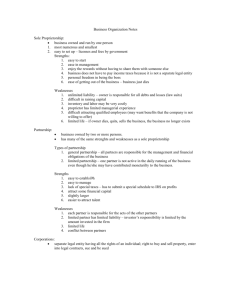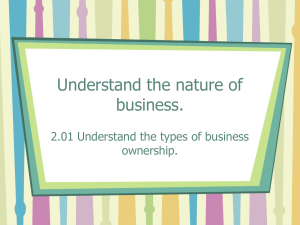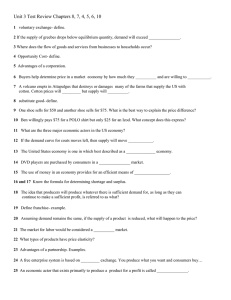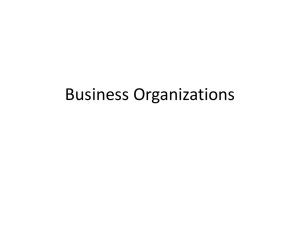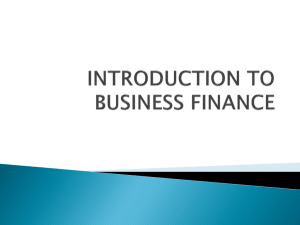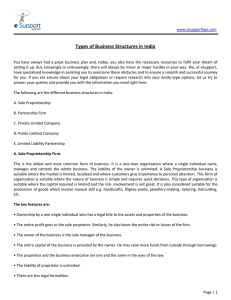Business Organizations
advertisement
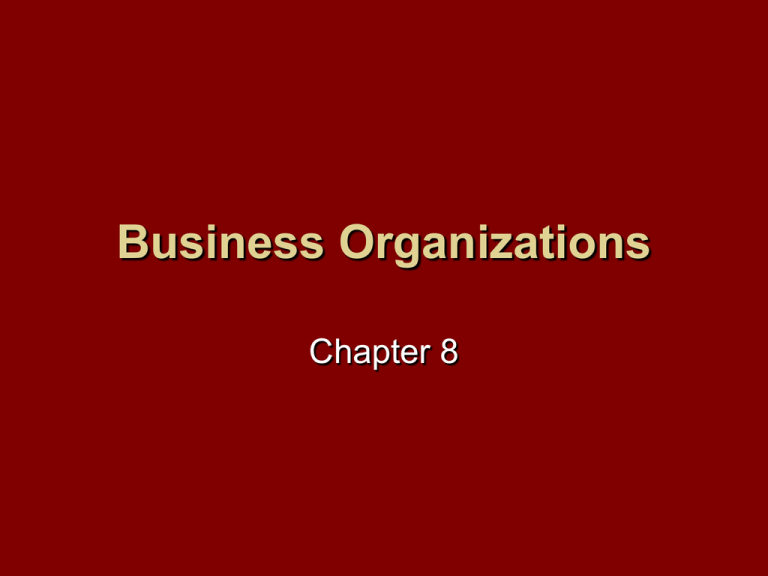
Business Organizations Chapter 8 Standard 14: • Students will understand that: Entrepreneurs are people who take the risks of organizing productive resources to make goods and services. Profit is an important incentive that leads entrepreneurs to accept the risks of business FOUR TYPES OF MARKET STRUCTURES HOMEWORK Business Organizations • A business organization is an establishment formed to carry on a commercial enterprise. • In other words, a business organization is a company, or firm. Sole Proprietorship • A sole proprietorship is a business owned and managed by a single individual • Owner is the company Sole Proprietorship Advantages - Disadvantages Ease of start up - Unlimited personal Relatively few regulations liability Sole receiver of profit - Limited access to Full control resources Easy to discontinue - Lack of LONGEVITY Partnerships - 3 TYPES • A partnership is a business organization owned by two or more persons who agree on a specific division of responsibilities and profits • 1. General partnership is one in which the members share equally in both responsibility and liability • 2. Limited partnership is one in which only one partner is a general partner (the others contribute only money) 3. LLP’S • LIMITED LIABILITY PARTNERSHIPS • LLP’S: ALL PARTNERS HAVE LIMITED PERSONAL LIABILITY • ATTORNEYS, ACCOUNTANTS, DENTISTS, PHYSICIANS CAN REGISTER AS LLP’S Partnerships Advantages Disadvantages - Ease of start up - Shared decision making and specialization - Larger pool of capital - Taxation –Individual pays income tax but business does not - Unlimited liability for at least 1 General Partner - Potential for conflict Corporation • A corporation is any business or firm that is a legal entity which is publicly owned and traded through stock. • A stock is a certificate of ownership in a corporation Corporation Advantages Disadvantages -stockholders -limited liability -corporation -many resources Easy to raise capital -longevity -stockholders -loss of control by owners -double taxation (dividends/capital gains) -corporation -difficulty and expense of start-up -more Gov. regulations • Horizontal mergers: merger between two companies selling similar or compatible products – larger market share • Vertical mergers: two companies that bought and sold products merge - efficiency • Conglomerates: when a corporation becomes large by purchasing other corporations. Think breakfast cereals TYPES OF TRADED CORPS. • PRIVATELY / CLOSELY HELD: SELL STOCK TO SELECT FEW (FAMILY MEMBERS, EMPLOYEES TO MOTIVATE SALES ONLY BOUGHT AND SOLD THROUGH THE COMPANY – THINK: WAFFLE HOUSE • PUBLICLY HELD: CAN BUY OR SELL STOCK THROUGH A BROKER ON THE OPEN MARKET (STOCK EXCHANGE, EX: NYSE, AMEX, NASDAQ) Organization Description Advantages Disadvantages Examples SOLE PROPRIETORSHIP OWNED & MANAGED BY SINGLE INDIVIDUAL, USUALLY SMALLER CO’S, REQUIRES: LICENSE, REGISTER NAME, STATE PERMIT, 75% OWNER GETS ALL PROFIT, EASY TO START UP OR STOP, FEW GOV. REGS, FULL CONTROL UNLIMITED PERSONAL LIABILITY (OWNER LEGALLY BOUND TO PAY BUS. DEBTS), IF FAILS, OWNER MAY HAVE TO SELL PERSONAL PROPERTY TO COVER DEBTS, LIMITED RESOURCES, LACK OF LONGEVITY LAWN CARE, NAIL SALON, HAIR SALON, PARTNERSHIP OWNED BY 2 OR MORE PERSONS DIVIDE RESPONSES/ PROFITS GENERAL: MOST COMMON, BOTH PARTNERS SHARE EQUAL RESPONSIBILITY/LIA BILITY LIMITED: ONLY 1 PARTNER (GEN.)HAS UNLIMITED PERSONAL LIABILITY BUT CONTROLS BUS, OTHER PARTNERS (LIMITED)ARE INVESTORS BUT DON’T ACTIVELY MANAGE BUS. LLP’S: ALL PARTNERS HAVE LIMITED PERSONAL LIABILITY 7% EASY TO START, FEW GOV. REGS., SHARED DECISION MAKING, SPECIALIZATION, MORE CAPITAL, PARTNERS PAY INCOME TAX BUT BUS. ITSELF IS NOT TAXED ON INCOME POTENTIAL FOR CONFLICT, UNLESS LLP AT LEAST 1 PARTNER HAS UNLIMITED LIABILITY, DOCTORS, LAWYERS, SMALL RETAIL STORES, FARMS, CONSTRUCTION CO’S, FAMILY BUSINESS ATTORNEYS, ACCOUNTANTS, DENTISTS, PHYSICIANS CAN REGISTER AS LLP’S CORP LEGAL ENTITY (BEING) OWNED BY INDIV. STOCKHOLDERS 20% STOCKHOLDERS HAVE LIMITED LIABILITY DEBTS, TRANSFERABLE OWNERSHIP, EASY CAPITAL, LONGEVITY DOUBLE TAXATION -TAXES ON INCOME/DIVIDENDS/CAPITAL GAINS),EXPENSIVE/DIFFICULT TO START UP(CHARTER), MORE GOV. REGULATIONS (REPORTS), OWNERS MAY LOSE CONTROL TO MANAGERS, MICROSOFT, IBM, COCA COLA FOUR TYPES OF MARKET STRUCTURES MOST COMPETITIVE LEAST COMPETITIVE PERFECT COMPETITION MONOPOLISTIC COMPETITION OLIGOPOLY MONOPOLY HOW EASY IS IT FOR SELLERS TO ENTER MARKET? Sellers enter & exit EASILY lower start up costs FEW BARRIERS TO ENTRY DIFFICULT TO ENTER, higher start up costs VERY DIFFICULT TO ENTER MARKET, high start up costs WHAT TYPE OF PRODUCTS ARE SOLD? IDENTICAL PRODUCTS SIMILAR BUT NOT IDENTICAL MUST DIFFERENTIATE BUILD BRAND LOYALTY SIMILAR OR IDENTICAL ONE MAJOR PRODUCT, NO VARIETY or SUBSTITUTES HOW MUCH CONTROL DO SELLERS HAVE OVER PRICES? NONE results in LOWER PRICES FOR BUYERS who are WELL INFORMED, SUPPLY & DEMAND DETERMINE PRICE SOME/ SLIGHT CONTROL BUT COMPETITION DRIVES PRICES WHICH VARY DUE TO DIFFERENTIATION (STORE, DESIGN, QUALITY) MORE CONTROL AS ONE LEADER SETS PRICE, INTERDEPENDENCE, PRICE LEADERSHIP PRICE WARS, COLLUSION TOTAL CONTROL BY SELLER MEANS HIGHER PRICES FOR BUYER # HOW MANY SELLERS ARE COMPETING IN THE MARKET? LARGE # OF SELLERS & BUYERS MANY BUYERS AND SELLERS FEW LARGE SELLERS DOMINATE MARKET 3-4 LGST PRODUCE 7080% ONE SINGLE SELLER GIVE EXAMPLES agricultural (peaches, apples) JEANS (GAP VS ABERCROMBIE), SOFT DRINKS, COMPUTER CELL PHONES, AIRLINES, AUTOS, CEREAL PUBLIC UTILITIES (WATER, SEWER) Review terms • Know these terms: a) Equilibrium b) Horizontal/vertical merger c) Resource allocation d) Price floor/ceiling e) Price system f) Collusion g) Cartel h) Differentiation i) Trusts j) Sherman Anti-trust Act k) Types of legal monopolies l) Types of market structures m) Types of business organizations n) Taft/Roosevelt o) Rent Control p) Black market q) Search costs

